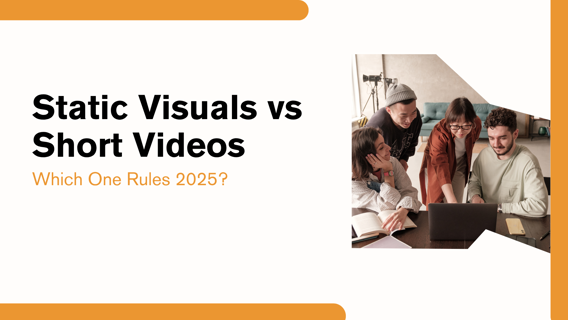
I’ve been staring at my screen for an hour, flipping between two tabs, one showing a looping reel of a coffee cup swirling in perfect lighting, and the other, a still photograph of the same cup. Both beautiful. Both telling a story. But here’s the thing, in 2025, the internet doesn’t sit still long enough to sip the coffee, you know? Everyone’s scrolling, swiping, skipping. So yeah, short videos, that’s where the noise is. But also, static visuals, they’re like the quiet kids in class who somehow get remembered. I’ve been in the design game long enough to know one thing: trends don’t replace each other; they collide.
I remember last year, sitting in my agency’s dim-lit studio, surrounded by the hum of monitors and the smell of burnt espresso (our designer, Kyle, always burns it). We were pitching a campaign for a sneaker brand. The client wanted something “punchy, Gen Z, fast.” You can already guess , short videos everywhere. Vertical edits, lo-fi beats, hands showing sneakers spinning mid-air. But the image that actually went viral? A single static shot. Just a worn-out pair of sneakers on a basketball court, shot during golden hour. No fancy transitions, no voiceovers. Just emotion. That’s when I realized this war , short videos vs static visuals , isn’t really about the format. It’s about connection.
The Rise of Short Videos (and Our Shrinking Attention Spans)
Let’s be real , our brains are now wired for speed. Scrolling through Instagram, TikTok, or whatever the next app of the year is, we process content like popcorn. One bite, next bite. And short videos fit right into that rhythm. They hit quick, make a point, and vanish before we even register how well they worked.
But here’s the irony. As our screens fill with all these looping clips, people are also craving something real. Something that doesn’t dance for attention. You can tell when a creator is faking authenticity , the too-perfect background, the exaggerated smile, the “relatable” captions that feel focus-grouped. It’s funny how short videos, which were supposed to be raw and spontaneous, have now become mini-commercials.
I once worked with a skincare brand that wanted “natural storytelling.” They pushed for a campaign of short videos showing morning routines , influencers washing faces in perfect morning light (which was actually a softbox at 2 p.m.). When we switched to a single static image , freckles, imperfections, the kind of detail only stillness reveals , engagement doubled. The world might love motion, but stillness still hits differently.
When Static Visuals Speak Louder
There’s a reason billboards haven’t died. A strong image, frozen in time, still has the power to make people stop. Static visuals aren’t just pictures; they’re moments. The kind that lets your eyes wander , the cracks on the wall, the texture of fabric, the depth of shadows.
I grew up sketching , not filming. I used to pause music videos just to draw a frame that caught me. Even now, when I see a well-composed static visual, something inside me slows down. It’s the opposite of instant gratification; it’s a quiet pull. And honestly, in a world screaming for attention, quiet is magnetic.
Last month, I was working on a digital campaign for an art festival. Everyone pushed for motion , short videos, flashy cuts, transitions, animations. I argued for stills. The winning post? A black-and-white portrait of a painter staring straight into the lens. No words. No sound. Just that stare. It reminded me that emotion doesn’t need speed. It needs truth.
Why Brands Keep Chasing Short Videos Anyway
Because they work. That’s the hard truth. Short videos grab impressions, drive conversions, and make algorithms happy. Social platforms feed off motion. The longer people watch, the more the system rewards you. So yeah, if you’re chasing reach, go for it.
But the downside? Saturation. Every brand looks the same after a while. The same jump cuts. The same background music. The same “Wait till the end!” captions. It’s exhausting. We’re drowning in creativity that looks identical.
And then, occasionally, you see a single image , an ad that says nothing but somehow says everything. That’s when you realize storytelling isn’t about how fast it moves. It’s about how long it stays with you.
The Design Layer: Balance Between Motion and Stillness
As someone who designs both , from quick reels to magazine covers , I can tell you the magic happens in the balance. Short videos pull people in, but static visuals keep them there. Think of them as rhythm and melody. One makes you dance, the other makes you feel.
A good campaign uses both. You lure them in with movement, and you leave them with a moment. That’s design psychology 101 , rhythm, pattern, emotion, pause. Without pause, rhythm collapses.
Sometimes when I’m editing visuals late at night, I pause the timeline just to take a screenshot of a perfect frame. That frame, without sound or motion, often tells the entire story better than the video does. It’s the irony of our era , movement reveals what stillness captures.
How the Audience Changed the Rules
We used to design for the audience. Now we design with them. The comment section has become part of the artwork. The reply videos, duets, stitches, all part of the narrative. Short videos thrive in this participatory chaos. But still visuals have their own rebellion, memes, posters, moodboards.
Have you noticed how people screenshot posts and share them instead of linking videos? That’s static communication surviving inside the motion culture. People still want something they can save, not just watch.
And honestly, that’s why I don’t think one rules over the other. 2025 isn’t the death of stills or the reign of reels , it’s the year of blending. The successful creators? They use both like instruments in a song. They know when to pause, and when to play.
A Quick Detour, From PDF to PNG and Beyond
Funny story: while designing assets for a client last month, we had to convert hundreds of files , yeah, the good old pdf to png process, just so the visuals would stay crisp in short videos. The irony still cracks me up. The same static images we converted ended up being the opening frames of the motion edits. Sometimes the tools overlap more than we realize.
Later, when reviewing analytics, I noticed that posts starting with those still PNG frames had better retention. Maybe our brains still crave that one second of stillness before movement begins. Maybe that’s why pdf to png conversions will always matter; they bridge design formats, not just file types.
The Psychology Behind It All
Movement captures instinct. Stillness captures memory. Simple as that. Motion makes you look, stillness makes you think. Our brains evolved to notice movement because it meant survival , something’s happening, pay attention. But what we remember? The still frames.
There’s a fascinating study (I’ll skip the jargon) showing how people remember paused moments in videos better than the full motion itself. Like how we remember a single smile from a movie, not the whole scene. That’s why short videos might rule the feed, but still visuals rule the heart.
The Future: A Creative Middle Ground
2025 feels like a hybrid year. Not the “pick one” era, but the “mix both” one. We’ll see creators merging short videos with still frames , micro-moments, looping pauses, cinematic stills within motion. Imagine a reel that freezes mid-scene, giving you a second to breathe before continuing. That’s the future , intentional pacing.
Brands that understand this will dominate. Those who rush every second will fade into noise. The trick isn’t to chase the algorithm; it’s to chase human rhythm. People don’t want speed. They want feeling.
Final Thoughts: What Really Rules in 2025?
If you’ve read this far, you probably expect a winner. Sorry, no clear champion here. Because storytelling never has one format. Short videos will dominate trends, yes. But static visuals will keep defining identity. One is the spark, the other is the shadow it casts.
When I close my laptop after a long day of editing, I scroll through my drafts. Among the dozens of videos, I always find one still , one image that just… lingers. Maybe that’s the answer. Motion grabs you. Stillness keeps you.
And in 2025, maybe the real art isn’t in choosing sides. It’s in learning how to make them dance together.
0 件のコメント
この投稿にコメントしよう!
この投稿にはまだコメントがありません。
ぜひあなたの声を聞かせてください。
